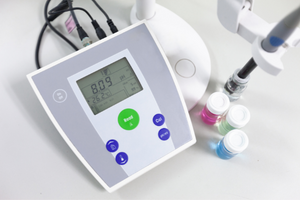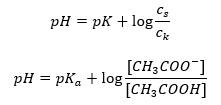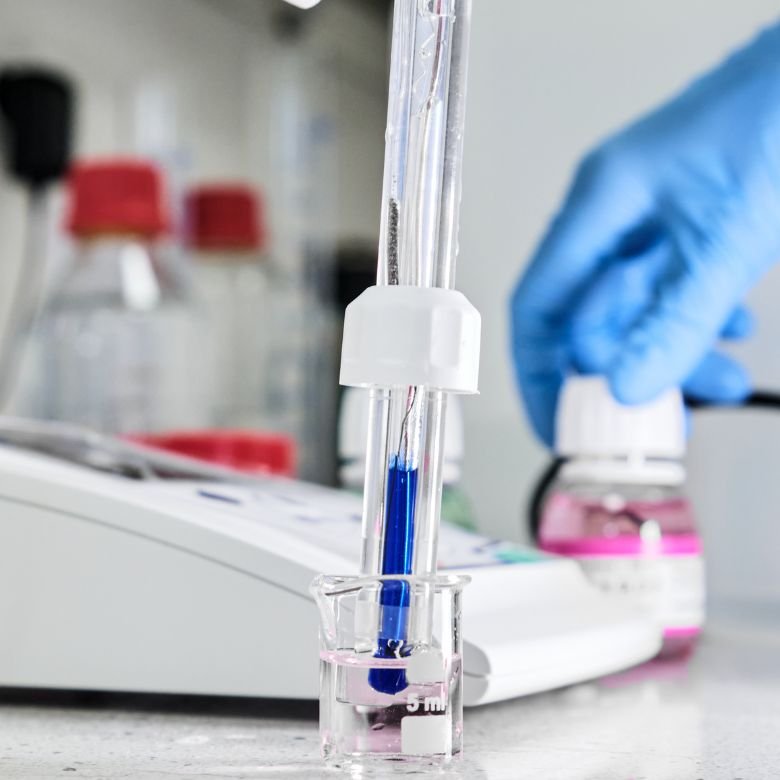The term “pH buffers” refers to such aqueous solutions which do not change their pH value despite introducing a small amount of bases or acids, or during dilution. In practical terms, they are mixtures of solutions of weak acids and their salts with concentrated strong bases (proton donor –proton acceptor) or, analogously, mixtures of solutions of weak bases and their salts with strong acids. The main goal of using buffer solutions is that they act as agents which enable maintaining the pH value at a fairly stable level. They are often used in a wide range of chemical applications, for example in dye manufacturing, during fermentation processes, as well as to determine the pH value of food products, cosmetics and pharmaceuticals.

The Henderson-Hasselbach equation
The principal dependency of the buffer’s pH value on the pKa or pKb used for the acid or base, respectively, as well as the ratio of the concentrations ofthe acid and its conjugate base or, analogously, the base and its conjugate acid, is defined by the Henderson-Hasselbach equation. It shows the correlation between the strength of the applied acid and the pH value. For a sample reaction of a buffer produced using a weak acid, the procedure is as follows:
HA + H2O ↔ H3O+ + A–
Whereas the correlation between [A–], that is the molar concentration of the conjugate base [mol·dm-3], [HA], being the molar concentration of the non-dissociated acid and the pKa – the negative logarithm of the equilibrium dissociation constant of the acid (Ka), expressed with the Henderson-Hasselbach equation for such a reaction, has the following form:

The Henderson-Hasselbach equation for an acetate buffer
The operating mechanism of buffers is based on the presence of ions, which are capable to bind hydrogen or hydroxide ions. When considering an acetate buffer, which is a mixture of acetic acid and sodium acetate, we should note down the dissociation reaction between a weak acetic acid and a strong electrolyte, sodium acetate (CH3COONa), which is completely dissociated into ions:
CH3COOH ↔ H+ + CH3COO–
CH3COONa → CH3COO– + Na+
Since the buffer solution is a mixture of these ions, the addition of a small amount of a strong acid introduces [H+] ions, which are immediately bound by CH3COO– anions to form acetic acid which is non-dissociated in these conditions. In consequence, this does reduce the pH value. In the same way, the supply of additional OH– cations by introducing a strong base to the solution will not increase the pH level. They will be immediately bound by H+ ions originating from the dissociation of the acetic acid into non-dissociated water molecules.
The equation defining the acid dissociation constant is presented below:

For the dissociation of weak acetic acid, the total concentration of the CH3COO– anion is defined by the concentration of ions originating from the dissociation of the salt, which, in turn, is the same as the concentration of the salt (cs), that is sodium acetate. A high concentration of these anions causes the concentration of H+ cations to decline and, consequently, the acid dissociation degree is reduced to keep the Ka value stable. Owing to this relationship, we can also assume that the number of non-dissociated CH3COOH molecules is practically identical to the total concentration of acetic acid (ck). This is why the dissociation constant can be noted down as follows:

Having taken the logarithm, we obtain a relationship that leads to the Henderson-Hasselbach equation:

Thus, the Henderson-Hasselbach equation has the following form:

To write out the relationships, the pKa value in the equation is in fact the measure of the acid’s strength. Any pKa values lower than 3 (-log(0.001)) are characteristic of strong acids, while the higher the value, the weaker the acid. The fact resulting from the Henderson-Hasselbach equation is the equivalence of the buffer solution’s pH value and the pKa of the acid at the moment when the ratio of the concentration of the non-dissociated acid and the concentration of the anion produced by the dissociation of the acid equals 1, as log(1) equals 0.
Such conditions exist as a result of titrating a weak acid with a strong base, if we add such an amount of the base that corresponds to half the amount required for the complete neutralisation of the acid. Then the solution titration degree is 50%. In the dependency between the pH and the volume of the titrant used, the pH value in the buffer area changes relatively slowly.

Example: ammonium buffer
Another type of buffer is the ammonium buffer, which is a mixture of a weak base (NH4OH) with a strong acid (NH4Cl). However, the mechanism is very similar. The salt present in the mixture undergoes complete dissociation, and its constant is the folloing equation:

Whereas the ammonium base is practically non-dissociated in the strong electrolyte (NH4Cl). For this reason, we assume that the concentration of the NH4+ cation is equal to the concentration of the salt, but the concentration of non-dissociated NH4OH molecules is identical to the concentration of the base. This makes it possible to formulate the equation and calculate the pH of that buffer.

The NH4+ and Cl– ions, and NH4OH molecules present in the ammonium buffer result in the fact that once we add an acid or base, the following reactions occur:
NH4OH + H+ ↔ NH4+ + H2O
NH4+ + OH– ↔ NH4OH
If the addition is small, the change in the base–salt concentration ratio, and thus the change of the pH, is also small. In case of a tenfold change in the ratio of these concentrations, the pH value will change by one unit.
Buffer capacity
The term “buffer capacity” refers to the capacity of a buffer solution to maintain an approximately constant acidity of a solution. More precisely, it is the number of gram-equivalents of a strong acid or strong base which, when added to 1 dm3 of a buffer solution, changes its pH value by one. The formula defining the buffer capacity (β) includes its dependence on the number of moles of a strong acid/base after addition to the buffer solution (Δn, [ml]) and the change in the pH observed while adding the volume of a strong acid or base to the buffer solution (ΔpH).
![]()
It is a value that strongly relates to the concentrations of the ingredients, which rises as they increase. The highest value of the buffer capacity characterises the buffer solutions whose pH is equal to the dissociation constant (pKa)of the acid used to produce them.
Operating principle of a phosphate buffer
A less popular type of buffers are those buffers that contain two acid salts. In this case, they are two acid salts of the orthophosphoric (V) acid, that is sodium phosphate monobasic (V) and sodium phosphate dibasic (V). Unlike the most common buffers, which are also based on the Brønsted principle of conjugate acid–base pairs, the nature of ingredients is not that easy to determine. As the anions present in the phosphate buffer show values characteristic of Brønsted acids, we should check the difference between them more carefully. According to that principle, the ion being the stronger acid must have a higher dissociation constant.
- For H2PO4– Ka = 6.34·10-8
- For HPO4-2 Ka = 4.36·10-13
If we have such data available, we can easily sttate that in this case it is the H2PO4-13 hydrogen anion that is the weak Brønsted acid. The buffer’s operating mechanism is based on a dynamic equilibrium that can be expressed by the following equation:
![]()
If we add small amounts of acid to the buffer solution, the system will try to prevent the changes in pH due to the reaction of blocking the effect of [H+] cations by protonating the hydrogen anion, according to the following equation:
![]()
The fact that it is the anion that will neutralise the buffers added to the solution is a consequence of the fact that it is that anion being the stronger Brønsted base. In such systems, we apply a rule stating that the stronger the Brønsted acid, the weaker its conjugate base. If we add an acid to a system containing several Brønsted bases, then the strongest base will be the first one to react. This relationship is the most important component when analysing the equilibriums existing in mixtures of aqueous buffer solutions consisting of a mixture of Brønsted acids and a mixture of weak Brønsted bases. The same rule, but in reverse order, applies when we add a basic solution into a phosphate buffer. The the OH– anions will be almost immediately captured by the stronger Brønsted acid present in the buffer. In this case, this will be the ion, and the reaction will take place according to the following equation:
![]()
Known buffers and their applications
- Blood maintains the values of 7.35 and 7.45 units, and its stability is guaranteed by the presence of carbonic acid, mainly in the form of dissolved carbon dioxide and HCO3- It is a buffer being a weak acid and its salt, and any addition of an excessive amount of acids or bases will cause conditions being hazardous to human life. A similar example of a buffer is saliva, whose pH is around 7.
- Ammonium, acetate, phosphate and borate buffers, so respectively:
- NH3 + NH4Cl pH = 8 – 11;
- CH3COOH + CH3COONa pH 3,5 – 6;
- K2HPO4 + KH2PO4 pH = 5,5 – 8;
- H3BO3 + Na2B4O7 pH = 7 – 9.
All popular buffers are applied where it is critical to maintain the pH at a constant level, so for example:
- in medicine, where they are administered intravenously to patients in critical condition;
- in microbial cultures, where the reaction of the soil is an important factor;
- in working with enzymes and proteins, to stabilise the environment for chemical reactions;
- in electroplating, where they are used for electrolytic baths, as they enable the prevention of quick, critical changes in their pH in the area near the electrode;
- for calibrating pH meters.